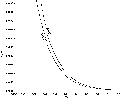![]()
Permanent magnet excitation was early recognized to have unique advantages for typical undulators. With an equivalent surface current of up to 106 A/m, available from modern materials, only costly superconducting or pulsed electro-magnet technology can compete. Further advances in material technology over the past decade, including higher quality Samarium-Cobalt and physically and magnetically stronger Neodymium-Iron-Boron, make this even truer today.
Initially pure magnet "Halback configurations" were used, but a newer "Hybrid" configuration, also attributed to Claus Halbach, is considered to have several important advantages. First, the fields within the gap tend to be dominated by the geometry of the highly permeable pole pieces, thus the effects of local regions of differing magnetization and orientation within a magnet block are reduced. Second, the perturbation on beam trajectory, caused by variations in strength between magnets, is reduced because such variations tend to contribute equally to adjacent plus and minus sinusoidal excursions of the field. Third, Peak field strength is higher both because the pole pieces concentrate more of the available magnetic flux within the gap region, and the demagnetizing field across magnet blocks is more uniform, allowing better advantage to be taken of the material.
 Illustration showing cross section of a hybrid undulator.
Ferro-magnetic pole pieces help uniformly distribute demagnetizing forces over the magnet blocks and concentrate the field
within the gap region.
Illustration showing cross section of a hybrid undulator.
Ferro-magnetic pole pieces help uniformly distribute demagnetizing forces over the magnet blocks and concentrate the field
within the gap region. [gif 3.5K]
Graph comparing field strength available from a hybrid undulator with that from a pure magnet "Halbach" configuration.
[gif 3.5K]
Graph comparing field strength available from a hybrid undulator with that from a pure magnet "Halbach" configuration.